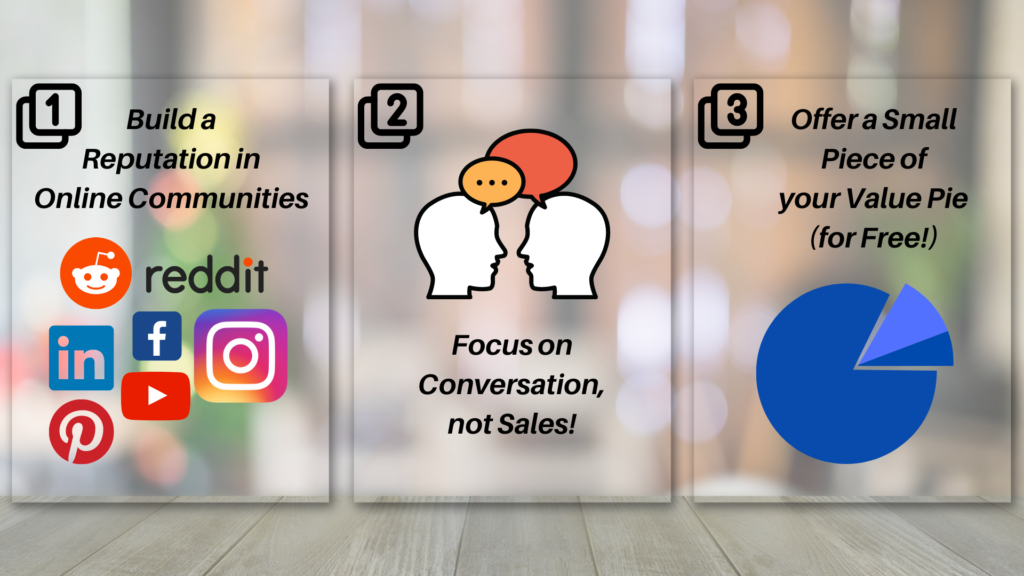Right after I graduated from college, the first startup that I ever joined sold standing desks at an exorbitant price of approximately 1,000 USD. As if that wasn’t shocking enough for me, a quick Google search revealed that most of our competitors’ products were tagged at half (or less than half) the price of our desks.
When I talked to my founder about this, he seemed unfazed.
“None of our competitors can offer the value and technology that we’re offering. We’re not selling desks, we’re selling a superior way of working.“
Everything I learnt about high ticket products: positioning, marketing and selling; I learnt at that startup. And today, I’m about to share that with you. We’ll touch upon the what, the why, some strategies, and how you can get into high ticket affiliate (digital) marketing.
So let’s get into it!
Table of Contents
What is High Ticket Digital Marketing?
A product/service is said to be a ‘high ticket’ item if it is expensive in contrast to other average products/services. Generally speaking, any item above the price mark of 1,000 US Dollars is considered to be a high ticket item.
Simply put, high ticket digital marketing includes all the promotional activities, tools, and strategies deployed across digital channels in order to generate leads and sell products/services that are high-priced.
I don’t know about you, but when someone like me comes across a product/service in that price range, my first and only reaction is “hell to the no“. However, when it comes to certain items like my phone, laptop, education, etc; I don’t shy away from paying a higher price. Why so? That’s because Apple has fully convinced me that an iPhone is the best choice through their marketing and positioning efforts.
Similarly, your private institution may have managed to convince you that its curriculum is far superior when compared to government colleges.
At the end of the day, you and I find more value in a private college and a Macbook Pro.
This is why implementing a carefully curated marketing strategy is crucial, especially when it comes to high ticket items. It can make or break a brand. Positioning matters more than anything.
But how is this any different from regular digital marketing efforts?
While the foundational principles may remain the same, there are some stark differences when it comes to high ticket digital marketing.
Regular Digital Marketing v/s High Ticket Digital Marketing
| Factor | Regular Digital Marketing | High Ticket Digital Marketing |
| Target Audience | Marketing communications are directed towards the masses since almost anyone can afford low to medium-priced products. | Marketing communications are directed towards a specific niche of customers that can afford to buy high-priced products. |
| Client Relationship | A personal relationship with every client isn’t required since marketing efforts cater to a large group of people. | A personal, one-on-one relationship is required to nurture leads and convert them into clients. |
| Lead Generation | The marketing goal is to generate as many leads as possible, without paying too much attention to whether or not they are qualified. | The marketing goal is to generate only qualified leads that fit a specific buyer persona and can be converted into clients. |
| Results | It generally doesn’t take too long for the results to show. | Persistent efforts may be required before the results show. |
Now that you can tell the difference between the two marketing approaches, which again, is mostly subtle, it’s time to explore the pros and cons when it comes to selling high-ticket items.
Pros & Cons of High Ticket Items
| Pros | Cons |
| Premium products typically have higher profit margins because of their high prices. This simply means more revenue and in turn more profits. | The market size of potential customers that are willing to buy high-ticket items is relatively smaller when compared to those seeking affordable options. |
| Since customers tend to associate higher pricing with superior quality and exclusivity, high-ticket products can give a brand a more premium image. | Selling high-ticket items often involves a longer sales cycle. Customers may require more convincing and personalized attention before the sale is closed. |
| Because of the higher prices, businesses need to make fewer sales in order to achieve their revenue targets and meet financial goals. | Even the niche group of customers that buy high-ticket items don’t do it as frequently. This limits the sales opportunity. |
| Businesses don’t have to spend as much on overhead costs because mass production is rare when it comes to high-ticket items. | Due to the higher price, some customers may experience buyer’s remorse if they feel they haven’t received the expected value from the purchase. |
Overall, in my opinion, if you’re someone who is up for a challenge, marketing and selling high ticket items can be an exciting avenue. However, if you prefer trendy content that sells quickly, you might want to stick to affordable, low-medium-priced items.
Additionally, you must be willing to commit the (long) time and effort it takes in order to grow the number of quality, high ticket clients.
Digital Marketing Strategies for High Ticket Items
Once you have made the decision of going all in, the next step would be to understand some unique strategies to market high-ticket items.
First things first: you need to make yourself familiar with the fundamentals of marketing in general. This means getting the following things right:
- Research your target audience:
The buyer persona that you’re trying to sell to should always be at the tip of your tongue. You should know your ideal customer through and through. What do they like? How do they spend their time? Where do they spend their time? What are their motivations? And so on. - Explore different marketing channels:
Don’t shy away from experimenting with all kinds of marketing channels: social media platforms, email marketing, paid marketing campaigns, etc. If there’s a chance that your ideal customer engages with a channel, you should utilise it. - Keep an eye out for competition:
Never shoot in the dark. You should always have a good understanding of who are your competitors, what are their offerings, and what’s a unique selling point that differentiates you from them.
Once that’s out of the way, you should be able to use all the information thus gathered and implement the following digital marketing strategies for high ticket items:

Build a Reputation in Online Communities
Now that you have researched your target audience, it shouldn’t be hard for you to find online communities in which your audience is active. This may be specific groups/pages across social media platforms, subreddits, YouTuber comment sections, etc.
Once you’ve found the hot spot, the next task is to build a trustworthy reputation. Share opinions and engage with others in discussion, and do this frequently over a span of a few months. This should be enough for people to take note of you. Some pro tips:
- Have a username that stands out (corny_pink_rabbit, controversial_chamelon_chrissy, etc.)
- If possible, select the option to get notified when there’s a new post (I have personally done this so that I can quickly add a comment that gets traction right from the start).
- Be bold. Don’t shy away from posting controversial opinions. Yes, sometimes even if it’s just engagement bait. (SOMETIMES)
The overall goal is to establish authority and get people to value your opinion.
Focus on Conversation, not Sales
When you join any community, you should consider the fact that you’re a newbie and that the others already have some sort of rapport with each other. If you attempt to sell something to them right away, they will not appreciate it in the least.
This is why it’s important to carry on conversations, build a relationship with the members, and only then attempt to generate leads. Even then, it’s important to find an appropriate window to do so. No one likes an abrupt interaction with a salesman.
Be patient, go with the flow, and see where that takes you. (Why has this started to sound like dating advice?)
Offer a Small Piece of your value Pie (for Free!)
Have you heard of the term freemium?
According to WallStreetMojo
Freemium is a customer acquisition model adopted by businesses to introduce basic products or services to users for free. It is a part of the pricing strategy to entice free users to upgrade to premium versions with more advanced features at a paid subscription.

If you’re able to provide value that is of quality to your users without charging them anything, there’s a high chance that they’ll already be motivated to upgrade to a premium model for better features. (Spotify, Ahrefs, YouTube, etc.)
Although some people may think that the freemium model invites losses, it is a great opportunity to put value at the forefront of your business and give people a chance to explore how your product/service can change their life.
Become More Empathetic
To be able to sell high ticket products, you need to be an empathetic person. Think about it:
If someone is willing to spend a large sum of money on a product/service even though there are cheaper alternatives available in the market, there must be some reason behind it. They are most likely unsatisfied because of an underlying problem or challenge that comes with buying the alternative item.
As a marketer, it’s your responsibility to understand this pain point and address it. The ability to do so effectively is what differentiates you from others and convinces your target audience to invest in your product/service.
High Ticket Digital Marketing Case Study (by STEEZY Digital)
The following case study is by STEEZY.Digital, a digital marketing & branding agency that offers branding, advertising, and copywriting Services to real estate professionals.
Unless we’re talking about Barbie houses, we all know that real estate is a supremely high ticket industry. And since Steezy works with realtors, their goal is to market and sell real estate properties. So, in the case study that follows, we’ll take a look at the strategies implemented by Steezy in order to nurture and convert their high-ticket leads into clients.
Right from the get-go, Steezy understood that high ticket closing takes a little extra human touch. The ability to talk with their leads and provide valuable information is what gives a realtor edge in the market. But does the human touch really need to be … human? Here’s how they went about it:
Bearing in mind the importance of generating sales conversations, Steezy decided to deploy Manychat – a chatbot that would speak to leads on behalf of the agents, 24×7, and on autopilot. Through Manychat’s templatized dialogue, Steezy managed to help realtors book more calls and close more deals.
p.s In case Chatbot advertising interests you, you should check out how Microsoft’s Bing is changing the game. Click here to read more.
The crux of Steezy’s strategy revolves around this philosophy:
You want to be available to answer any questions buyers may have to smooth out the process. If you can build a strong relationship with potential homebuyers, you have a higher chance of turning them into new business.
At the end of it all, Steezy managed to:
- Close 5 home deals in 6 months
- Generate $1.45M in sales at a 3% commission rate.
- Spend only $600 a month, resulting in a 12X ROAS.
- Generate $43,500 in gross commissions.
Now that’s digital marketing for high-ticket items done right. 😎
How to get into High Ticket Digital Marketing?
One of the most common ways for people to tap into high-ticket clients is through affiliate marketing.
Several high-ticket products and services offer affiliate commissions, so as long as you have an active audience on any social platform (Linkedin, Instagram, Facebook, etc.), you should be able to start off immediately.
As I did, you could also join the marketing team of a startup that sells a high-ticket item. That way, you’ll get to specialise in marketing one particular product/service.
Lastly, you could also join a marketing agency like Steezy that deals with high-ticket clients. You’ll gain exposure to a wide range of products and services.
Conclusion
While there are several other blogs that talk about high ticket marketing, I’ve attempted to summarize all the necessary information in this one post. At the end of the day, the best way to learn more about any given topic is to jump right in and get your hands dirty.
Reach out to relevant connections in your network and seek opportunities to work as a high ticket digital marketer. Or maybe you could start an affiliate blog.
Whatever it may be, don’t wait for the “right time”. F*ck around and find out!
Until next time, Tiddles out!
Frequently asked questions
What is High Ticket Digital Marketing?
High ticket digital marketing includes all the promotional activities, tools, and strategies deployed across digital channels in order to generate leads and sell products/services that are high-priced.
How to get into High Ticket Digital Marketing?
One of the most common ways for people to tap into high ticket clients is through affiliate marketing. You could also join the marketing team of a startup that sells a high ticket item. Lastly, you could also join a marketing agency that deals with high ticket clients.

